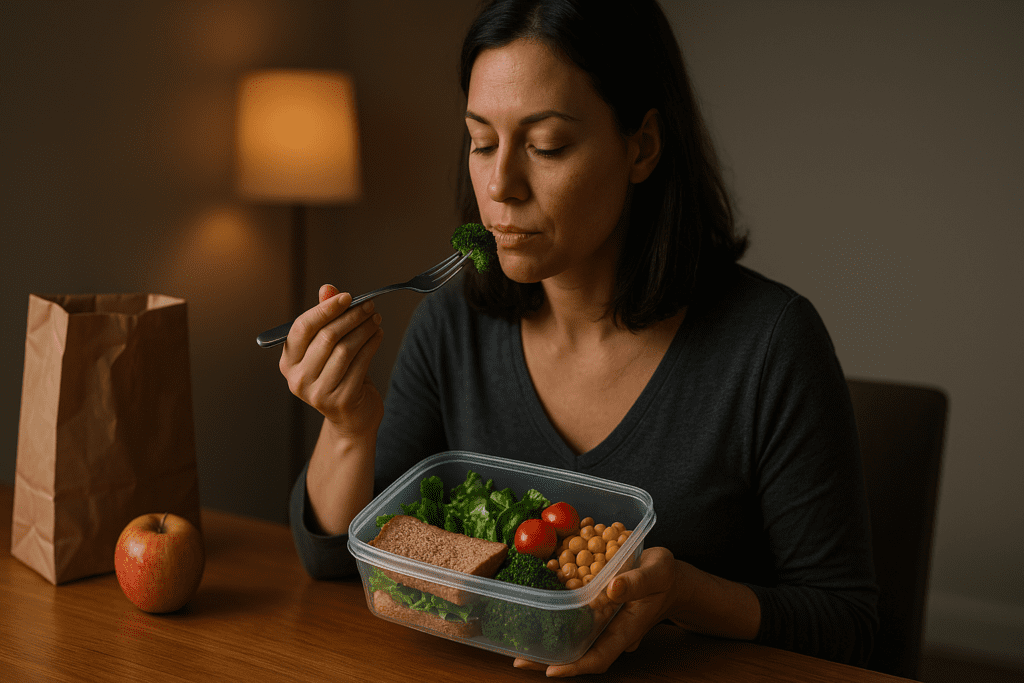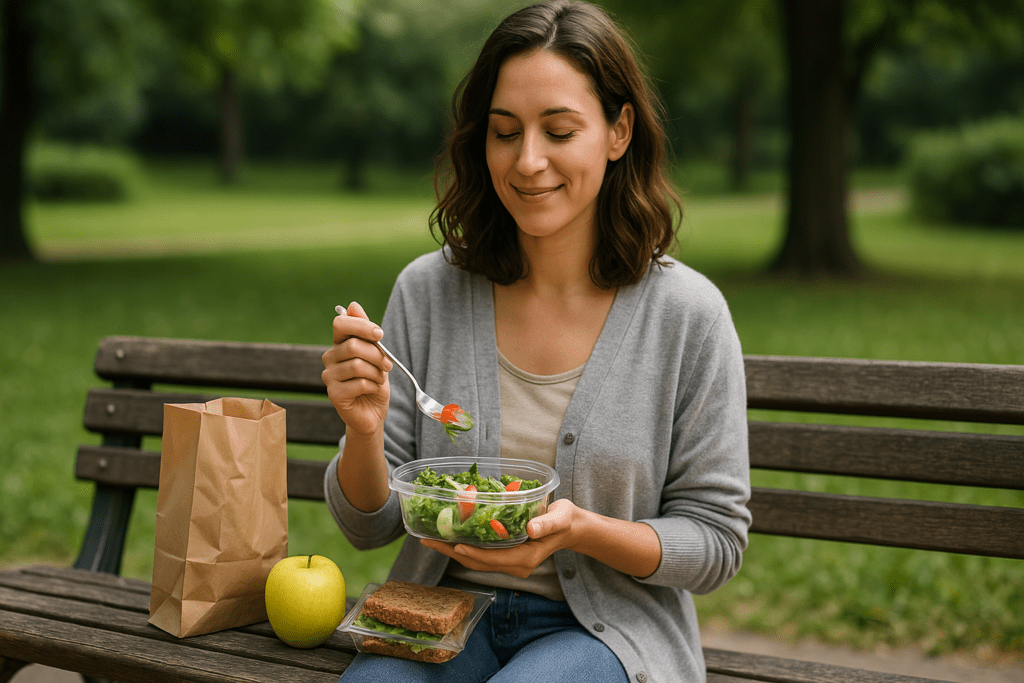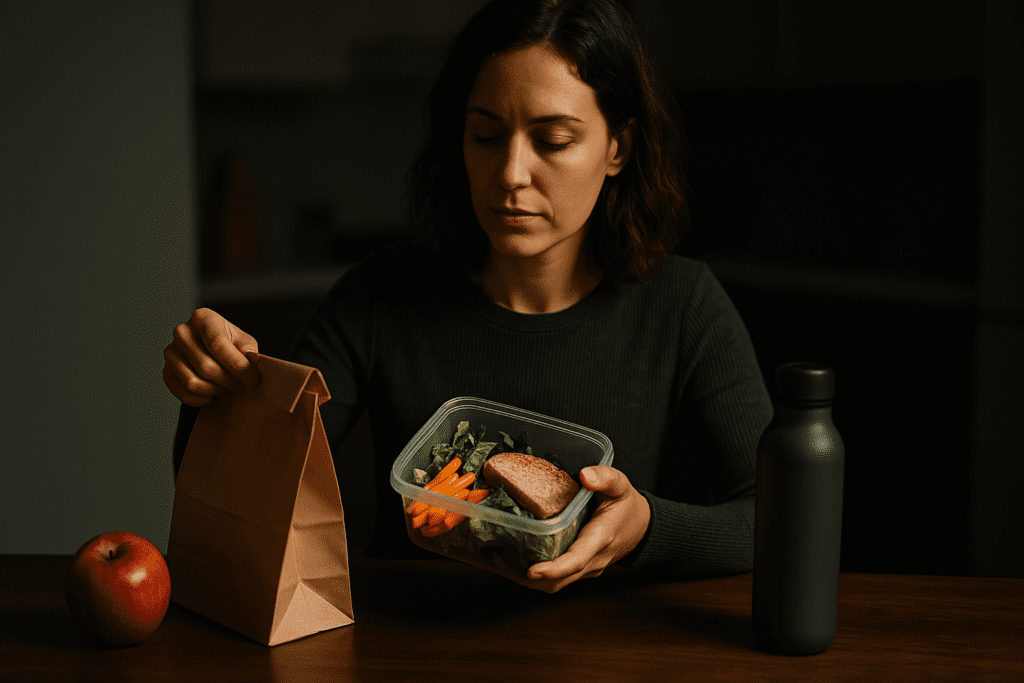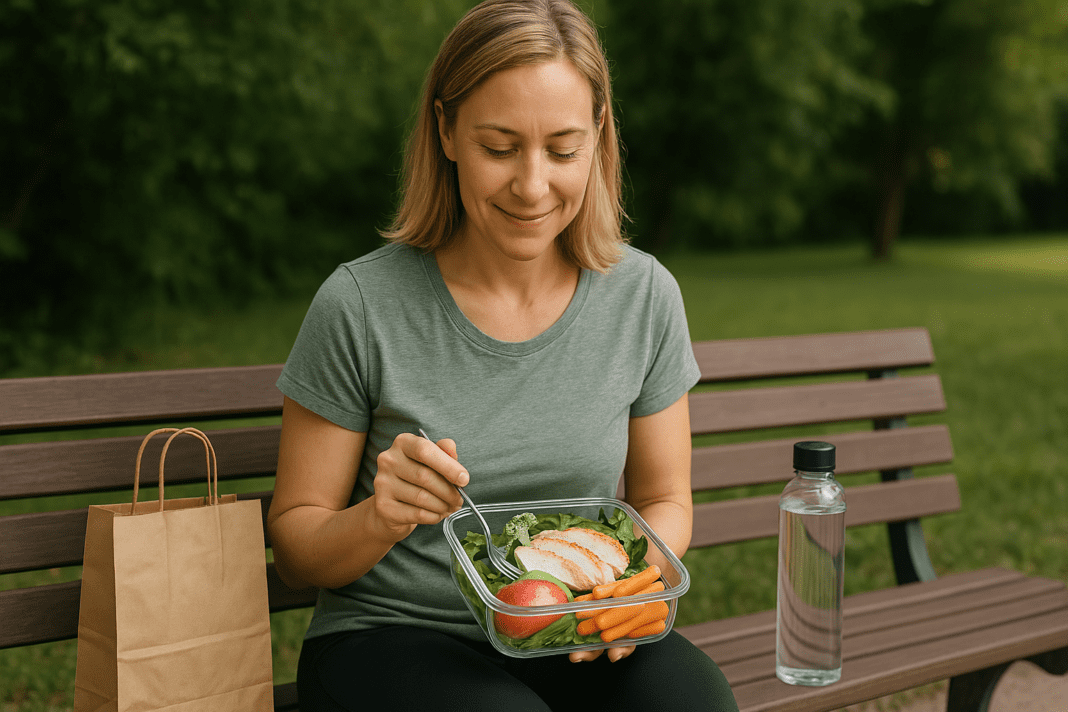Why Healthy Sack Lunches Matter for Adults: A Foundation for Everyday Wellness
In today’s fast-paced world, the concept of the traditional lunch break has undergone a quiet but significant transformation. Many adults find themselves eating at their desks, grabbing fast food between meetings, or skipping lunch altogether. Amidst this rush, the humble sack lunch has emerged as a powerful tool for reclaiming health, structure, and intentionality. Far from being a relic of childhood, thoughtfully prepared bag lunch ideas can play a meaningful role in supporting adult wellness—physically, mentally, and even financially.
You may also like: Smart Healthy Eating Tips for Busy Professionals: How to Stay Nourished When You’re Always on the Go
Adults face a unique set of nutritional challenges. Whether you’re managing the demands of a full-time job, balancing family responsibilities, or navigating a busy graduate school schedule, fueling your body properly during the day often falls to the bottom of the priority list. The appeal of healthy sack lunch ideas lies in their practicality—they offer control over ingredients, portion sizes, and overall nutritional quality. This autonomy can be especially valuable when dining options are limited or inconsistent in the workplace or on campus.
The benefits of embracing adult-appropriate bag lunch ideas go well beyond convenience. Homemade lunches are typically lower in sodium, unhealthy fats, and added sugars than restaurant fare. They can also be tailored to support dietary needs such as plant-based eating, gluten intolerance, or low-glycemic goals. Furthermore, research consistently shows that individuals who eat home-prepared meals tend to consume more whole foods, fewer ultra-processed items, and a wider variety of vitamins and minerals—factors all linked to long-term health and vitality.
From a psychological standpoint, a prepared lunch can instill a sense of routine and self-care in the midst of a chaotic day. Taking a moment to enjoy a well-balanced meal can reduce stress, improve focus, and even foster mindful eating habits that carry into dinner and beyond. With a bit of planning and creativity, your midday meal can transform from a rushed afterthought into a reliable pillar of your wellness strategy.
Nutritional Principles Behind Building a Smart Sack Lunch
Creating a nourishing sack lunch doesn’t require culinary expertise or hours in the kitchen. However, a basic understanding of nutrition is essential to ensure that your meals are balanced, satisfying, and supportive of your long-term health goals. A well-composed lunch should ideally include complex carbohydrates, lean protein, healthy fats, and an array of colorful vegetables or fruits. This combination not only provides sustained energy but also helps regulate blood sugar, support muscle function, and keep you feeling full throughout the afternoon.
Complex carbohydrates such as whole grains, legumes, or starchy vegetables are crucial sources of fiber and slow-digesting fuel. These foods prevent the energy crashes that often follow high-sugar or highly refined lunches. Brown rice, quinoa, whole-grain wraps, or even lentil pasta make excellent base options for grain bowls or sandwiches. Coupling these with high-quality protein—such as grilled chicken, boiled eggs, tofu, or canned salmon—ensures that your muscles have the amino acids they need for repair and recovery.
Fats are often misunderstood in the context of healthy eating, but they’re indispensable in the right forms. Unsaturated fats from sources like avocado, olive oil, hummus, or nuts help support cognitive function and vitamin absorption. Including these in your bag lunch ideas can elevate both flavor and nutritional value. Lastly, the inclusion of fresh vegetables or fruits adds fiber, antioxidants, and key vitamins like A, C, and K. Whether raw, roasted, or blended into a dip or smoothie, plants should play a starring role in your lunchbox.
Hydration should not be overlooked. While technically not a component of the sack lunch itself, having water, herbal tea, or even a naturally flavored electrolyte drink can enhance digestion and prevent the fatigue often mistaken for hunger. Together, these elements create a holistic, nutrient-dense meal that aligns with both physical wellness and dietary enjoyment.

Elevating the Everyday: Creative and Easy Sack Lunch Ideas for Adults
Moving beyond the classic peanut butter sandwich, today’s sack lunch ideas for adults offer a world of flavorful, nutritious possibilities. One of the most versatile formats is the bento box-style lunch. By separating your meal into compartments, you can include a range of items—say, grilled chicken skewers, edamame, brown rice, and a side of fruit—without needing to commit to a single dish. This method not only keeps things visually appealing but also allows for easier portion control and variety.
Another standout option is the mason jar salad. These layered lunches keep ingredients fresh and crisp, especially when the dressing is stored at the bottom and the greens are packed on top. You might start with a base of lentils, chickpeas, or quinoa, followed by chopped vegetables, seeds, and arugula or spinach. Topped with a drizzle of vinaigrette or tahini-based dressing, these salads travel well and can be customized endlessly.
Wraps are also an excellent vehicle for nutrient-rich ingredients. A whole-grain tortilla or collard green wrap can be filled with roasted vegetables, hummus, grilled tofu, or sliced turkey for a portable, satisfying option. Add a small container of fruit or Greek yogurt on the side, and you’ve built a complete meal in under ten minutes.
For colder months, thermos-based lunches provide warmth and comfort while maintaining nutritional integrity. Hearty soups—like minestrone, lentil, or sweet potato and black bean—can be made in bulk and portioned out for the week. These dishes often improve in flavor over time, making them ideal for meal prep enthusiasts. Pair with a slice of whole-grain bread or a boiled egg for extra sustenance.
Finally, don’t overlook snackable lunches. A curated assortment of items like cheese cubes, veggie sticks, whole grain crackers, hard-boiled eggs, olives, and a piece of dark chocolate can make for a satisfying and well-rounded meal. These bag lunch ideas are particularly appealing when your appetite is smaller or your schedule fragmented, allowing you to nibble throughout the day without sacrificing nutrition.
Time-Saving Strategies for Consistent Lunch Prep
Consistency is key to making healthy sack lunches a sustainable habit, and that consistency begins with preparation. The most successful lunch strategies often start with batch cooking. By dedicating one or two hours during the weekend to prepare staple ingredients—like roasted vegetables, grains, proteins, and sauces—you can mix and match components throughout the week without falling into a culinary rut. This modular approach also supports diverse nutritional needs and accommodates spontaneous cravings or changing weather.
Investing in quality storage containers is another practical step toward long-term lunch success. Glass or BPA-free plastic containers with tight-fitting lids keep food fresh and prevent leaks, while compartmentalized containers help organize multiple components without mixing textures. Labeling your meals by date or content can also reduce decision fatigue during busy mornings.
Freezer-friendly recipes provide an added layer of convenience. Soups, stews, burritos, and veggie-packed muffins can be made in larger quantities and frozen in individual portions. This way, when time is short, you can still rely on a nourishing, homemade meal that’s ready to grab and go. Planning your weekly menu in advance, even if only loosely, can minimize the stress of daily decision-making and reduce the likelihood of defaulting to less healthy options.
Taking five minutes each night to assemble your bag lunch ideas can save you valuable time in the morning and set a positive tone for the next day. By involving your senses—choosing vibrant colors, diverse textures, and satisfying flavors—you transform the lunch-packing process into an act of self-care rather than a chore. With these strategies, healthy eating becomes less about willpower and more about planning, structure, and intention.

Addressing Common Challenges with Healthy Sack Lunches
Despite the clear benefits, many adults struggle with sticking to a routine of packing lunch. Time constraints, lack of inspiration, and concerns about food safety or taste are among the most common hurdles. Fortunately, each of these can be addressed with mindful planning and practical solutions. One of the most effective ways to overcome the time barrier is to shift your mindset from day-by-day planning to weekly preparation. Having go-to recipes and a stocked pantry can reduce the amount of effort needed to prepare lunches consistently.
Taste fatigue is another legitimate concern. Eating the same salad or sandwich multiple times a week can become monotonous, leading to reliance on less healthy convenience foods. To combat this, try rotating your core ingredients—such as switching between lentils, farro, or sweet potatoes for your carbohydrate base—and incorporating different seasonings or sauces. Global flavor profiles like Mediterranean, Thai, or Mexican can offer exciting variation while still aligning with your wellness goals.
Storage and food safety are important, especially when packing perishable items like dairy, meat, or seafood. Using insulated lunch bags and ice packs helps maintain safe temperatures until lunchtime. Similarly, choosing shelf-stable components like nut butters, canned tuna, or roasted chickpeas can reduce your reliance on refrigeration. The key is to understand your environment and build your sack lunch ideas accordingly.
Social and cultural perceptions may also influence your lunch habits. In some workplaces, ordering food may be viewed as a norm or a networking opportunity. While it’s perfectly reasonable to participate in communal meals occasionally, bringing your lunch doesn’t have to isolate you. In fact, inviting others to join you in a “bring-your-own” lunch club can foster community while supporting shared health goals.
Lastly, don’t aim for perfection. Not every lunch needs to be Instagram-worthy or perfectly macro-balanced. The goal is to cultivate consistency, not rigidity. Flexibility and self-compassion are crucial for turning a well-intentioned habit into a lasting lifestyle change.
How Sack Lunches Support Broader Wellness Goals
Healthy eating is just one piece of a holistic wellness puzzle, and your daily lunch can act as a linchpin connecting nutrition with broader goals like stress management, productivity, and even environmental sustainability. When you prepare your own meals, you not only gain control over what goes into your body but also make choices that align with your values—whether that means eating more plants, reducing waste, or prioritizing seasonal ingredients.
From a psychological perspective, bringing a homemade lunch can also reduce decision fatigue, a phenomenon in which the brain becomes overwhelmed by too many choices. By predetermining your lunch plan, you conserve mental energy that can be better applied to work tasks or creative endeavors. This reduced cognitive load, paired with stable blood sugar from balanced meals, enhances your ability to focus, concentrate, and manage stress throughout the afternoon.
Financial health is another overlooked benefit. With restaurant meals averaging around $15 per serving and homemade options often costing a fraction of that, the cumulative savings from packing lunch five times a week can be significant—amounting to over $3,000 annually. This money can then be redirected toward other wellness investments, such as gym memberships, therapy, or high-quality food for home-cooked dinners.
Environmentally, adopting more sustainable bag lunch ideas—like using reusable containers, avoiding individually wrapped items, and incorporating plant-based ingredients—can reduce your ecological footprint. These seemingly small decisions compound over time, reflecting a commitment to health that extends beyond your own body to the health of the planet.
Above all, sack lunches symbolize intentionality. They’re not just about what you eat, but why and how. In that sense, they become a daily act of self-alignment, reinforcing your long-term vision for health and happiness with every bite.
Frequently Asked Questions: Healthy Sack Lunches for Adults
1. How can I keep my sack lunch ideas exciting over time without falling into a flavor rut?
Keeping your lunch routine fresh and exciting is all about incorporating variety—not just in ingredients, but also in textures, colors, and global flavors. Rather than relying on the same sandwich or salad each day, consider rotating cuisines weekly. For example, explore Mediterranean-themed bag lunch ideas one week, then switch to Asian-inspired rice bowls the next. Utilizing different herbs, spices, and condiments—such as chimichurri, harissa, or miso dressing—can bring unexpected complexity to even the simplest ingredients. Including a small “surprise” item, like a seasonal fruit or a piece of dark chocolate, can make the experience more enjoyable and sustainable long-term.
2. What are some underutilized ingredients that work well in adult sack lunch ideas?
Many nutritious and flavorful ingredients are often overlooked when planning sack lunch ideas for adults. Roasted chickpeas, marinated artichoke hearts, or pickled red onions can add bold taste and crunch to wraps or salads without much effort. Incorporating fermented foods like kimchi or sauerkraut supports gut health while providing a unique tang that elevates even basic dishes. For added plant-based protein, hemp seeds or tempeh are excellent alternatives to more common options. Including nutrient-dense spreads like walnut pesto or tahini instead of mayo or mustard can also diversify your bag lunch ideas without complicating prep time.
3. How can I adapt sack lunch ideas for adults with specific dietary restrictions, like gluten intolerance or low-sodium needs?
Adaptability is key when it comes to customizing bag lunch ideas to meet individual dietary needs. For gluten intolerance, replace wheat-based components with rice wraps, corn tortillas, or gluten-free pasta. Low-sodium lunches can benefit from using fresh herbs, lemon juice, and salt-free spice blends to enhance flavor naturally. Legumes, brown rice, and unsalted seeds are great foundational ingredients that are both filling and heart-friendly. Individuals with more restrictive diets may benefit from building a mix-and-match chart of safe ingredients to simplify planning and ensure variety. Experimenting with naturally allergen-free whole foods like quinoa, roasted vegetables, and grilled fish can help maintain nutritional balance.
4. What are some ways to encourage consistency with packing bag lunches during a busy workweek?
Creating consistency often starts with habit-building and small wins. One effective strategy is to prep lunch components in large batches on the weekend—such as roasting vegetables or cooking a protein—and then simply assemble throughout the week. Another helpful approach is establishing a “default lunch” template that you return to when creativity or time is low. You might also try scheduling your lunch prep as you would a meeting or gym session, treating it as an investment in your health. Keeping a running list of quick, go-to sack lunch ideas in a note app can eliminate decision fatigue. Finally, storing your packed bag lunch by your keys or laptop each night makes forgetting it the next morning much less likely.
5. How can I reduce food waste while preparing bag lunch ideas every day?
Minimizing food waste while prepping lunches is both eco-conscious and budget-friendly. Start by planning lunches around what’s already in your fridge or pantry, using perishables like leftover roasted vegetables or half-used condiments creatively. Repurposing last night’s dinner into a wrap, grain bowl, or frittata can save time and reduce spoilage. Embrace flexible recipes that work with substitutions, allowing you to use what you have rather than buying new ingredients for every meal. Buying in bulk and freezing single portions of soups, stews, or grains is another smart strategy. Composting scraps and reusing containers also contribute to a more sustainable approach to daily sack lunch ideas.
6. What are some psychological benefits of sticking to a regular bag lunch habit?
Beyond physical health, packing your lunch can contribute significantly to mental wellness. Preparing your own meals fosters a greater sense of control and self-discipline, which can translate into reduced anxiety and improved self-esteem. Eating a familiar, home-packed meal in a predictable environment can also create a grounding midday ritual, offering emotional stability amid a hectic workday. The creative process of planning bag lunch ideas can even serve as a form of self-expression or mindfulness. Plus, the financial predictability of bringing your lunch may ease long-term money stress, supporting a more holistic definition of personal wellness.
7. How do social dynamics at work affect the choice to bring a sack lunch?
Workplace culture can play a surprisingly large role in lunch decisions. In some office environments, there’s social pressure to dine out or attend group lunches, which may unintentionally discourage people from bringing a homemade meal. However, initiating a “lunch-from-home” group or inviting coworkers to a communal dining area can help normalize and even celebrate sack lunch ideas. Demonstrating the variety and quality of your own meals might inspire others and reduce any perceived stigma. It’s also worth considering that remote or hybrid work setups offer more flexibility and privacy for those who want to focus on health-driven bag lunch ideas without external pressure.
8. Are there any new technologies or tools that can make preparing sack lunches more efficient?
Innovations in kitchen tools and tech are making meal prep more streamlined than ever. Electric lunchboxes that heat food on the go are ideal for those without microwave access, while bento-style smart containers can help track nutritional data via a mobile app. Vacuum-sealing machines preserve freshness longer, allowing ingredients like chopped vegetables or pre-cooked proteins to last several days. Voice-activated grocery list apps and meal-planning platforms can simplify shopping and scheduling. By leveraging these tools, busy professionals can integrate sack lunch ideas into their routine without sacrificing time or quality.
9. How can I involve family or housemates in preparing sack lunches while maintaining individual preferences?
Collaborating with others in your household to plan and prep lunches can make the process more efficient and even enjoyable. One effective method is to establish a shared “lunch station” in your fridge or pantry, stocked with universally liked staples such as grains, protein options, veggies, and sauces. You can then each assemble personalized meals using the same core ingredients, reducing prep time while honoring individual tastes. This model allows for a more communal approach to bag lunch ideas while still respecting dietary differences. Involving children in packing their own lunch also teaches independence and nutritional awareness—skills that extend well into adulthood.
10. What long-term health and wellness trends are influencing how adults approach sack lunch ideas today?
Several macro-level trends are shaping the way adults approach lunch habits, particularly those rooted in sustainability, functional nutrition, and mental health. There’s growing interest in plant-based bag lunch ideas not only for their health benefits but also for their reduced environmental impact. The rise of personalized nutrition—tailoring meals based on genetic, metabolic, or microbiome data—is beginning to influence what people pack, even on a daily basis. Additionally, there’s an increasing emphasis on how food choices affect cognitive function, stress levels, and mood, prompting more people to opt for lunches rich in omega-3s, complex carbs, and adaptogens. These shifts reflect a deeper cultural movement toward using lunch as a means to nourish not just the body, but the mind and planet as well.

The Takeaway: Simple Bag Lunch Ideas Can Fuel Complex Wellness Goals
As we’ve explored, healthy sack lunch ideas for adults go far beyond convenience—they represent a deliberate, empowering choice to take control of your nutrition, energy, and overall well-being. With the right combination of planning, creativity, and commitment, your lunch can become a daily source of strength and nourishment. Whether you prefer vibrant salads, hearty soups, global flavor profiles, or protein-packed snack boxes, there’s a bag lunch idea out there that can fit seamlessly into your lifestyle.
More than just a midday meal, these lunches are micro-habits that reinforce your values, support your body, and protect your time and money. They encourage mindfulness, fuel your brain, and create opportunities for environmental and financial stewardship. Each choice you make in preparing your lunch reflects a broader dedication to holistic health—one that can ripple outward into other aspects of your life.
In embracing the simplicity of a sack lunch, you’re also embracing a powerful tool for transformation. When healthful eating becomes second nature, when routines become rituals, and when nourishment is a source of joy instead of stress, that’s when wellness becomes sustainable. With easy and nutritious bag lunch ideas tailored for real adult lives, you can nourish not just your body, but your entire lifestyle—one delicious, intentional meal at a time.
healthy lunch ideas for work, nutritious meal prep for adults, adult lunchbox inspiration, balanced meals on the go, portable healthy meals, easy lunch recipes for professionals, wellness-focused meal planning, smart eating habits for adults, lunch ideas for busy schedules, whole food lunch recipes, nutritious lunch for energy, workplace nutrition tips, affordable healthy meals, DIY meal prep strategies, fiber-rich lunch recipes, protein-packed lunches, clean eating lunch tips, sustainable meal prep ideas, healthy eating at the office, mindful nutrition for adults
Further Reading:
17 Healthy Lunch Ideas for Weight Loss
20 Low-Carb Lunch Ideas for Work That Will Actually Fill You Up
Disclaimer
The information contained in this article is provided for general informational purposes only and is not intended to serve as medical, legal, or professional advice. While NewsHealthWatch strives to present accurate, up-to-date, and reliable content, no warranty or guarantee, expressed or implied, is made regarding the completeness, accuracy, or adequacy of the information provided. Readers are strongly advised to seek the guidance of a qualified healthcare provider or other relevant professionals before acting on any information contained in this article. NewsHealthWatch, its authors, editors, and contributors expressly disclaim any liability for any damages, losses, or consequences arising directly or indirectly from the use, interpretation, or reliance on any information presented herein. The views and opinions expressed in this article are those of the author(s) and do not necessarily reflect the official policies or positions of NewsHealthWatch.

